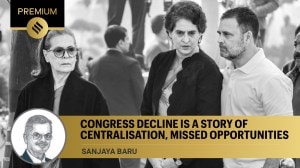A million partitions?
India has overworked and overlapped every possible permutation and combination of Difference...

India has overworked and overlapped every possible permutation and combination of Difference, miraculously lasting so long without forgetting its name or names, self-given or donated.
The 8220;Gorkhas8221; of north Bengal are distinct from the Bengalis of the plains and those of the hills. But, India8217;s organic nature means each of its myriad parts reflects attributes of the whole. Thus the heterogeneous ethnic cauldron of the hills, and the fact that the Gorkha identity is multi-ethnic, manufactured and amorphous 8212; one that has evolved over time, with its origins disputed, and continues to undergo more, but motivated, evolutions.
Some assume that the Gorkhas name themselves after the Gorkha district in Nepal. While this may appear a rational etymology, others trace the Gorkhas to the 8th-century warrior-saint Gorakhnath and his Rajput disciple, Rawal. In this mix of history and legend, Rawal8217;s descendents moved to present-day Nepal, and in the early 16th century, overran an area that would be named Gorkha after them. For the British, even the tribes of Rai, Gurung, Limbu, Magar, etc were 8220;non-Kshatriya Gorkhas8221; who provided the bulk of Gorkha soldiers, while the Thakuris and Chhetris 8220;Kshatriya Gorkhas8221; made officers. The Gorkhas are indeed a brave and tough people. Ironically, this truism is based on the greatest sociological myth invented by the British in India: 8220;martial8221; and 8220;non-martial8221; races.
Bimal Gurung8217;s search for the Gorkhas8217; identity as Indians, through a separate state, assumes that a political boundary is enough to define and confine identity. Therefore, despite the Gorkha Janmukti Morcha8217;s rhetoric about socio-cultural aspirations, the struggle for Gorkhaland is a case of identity politics. The Gorkha heterogeneity is being compounded by subsuming everybody 8212; Bhutias, Lepchas, Tibetans, Sherpas, etc 8212; under the Gorkha identity. As a result, when Gurung says that the struggle is not communal, not divisive, that all the hills peoples demand 8220;Gorkhaland8221;, we know that the 8220;Gorkha8221; identity has grown exponentially. By the time of the first demand for a separate administrative set-up for Darjeeling around 1907, the Gorkhas and the non-Gorkha tribes were already converging towards the umbrella identity of 8220;hill people8221;.
The Darjeeling hills belonged to the Sikkimese hill tribes. The Gorkhas overran them in the 18 and 19th centuries, losing the area to the British through the Treaty of Sugauli in 1816. The British returned the land to the Sikkimese, but decided to annex it to the empire once they realised how good it was to have sanatoriums and summer retreats. The majority of 8220;Gorkhas8221; in Darjeeling today can be traced back to Nepalese migrations for jobs during the Raj. In the mirror of history, therefore, except for the indigenous tribes, Gorkhas, Bengalis, Marwaris, Biharis, and others are all 8220;outsiders8221; in the Darjeeling hills. But GJM claims that its struggle has the support of all. To say that you will take them all in, in your distinctly ethnic entity of Gorkhaland, is thus an unworkable contradiction.
But to say that 8220;Gorkhaland8221; is needed for better administration and faster economic development may be justified. Except Jharkhand, smaller states have proved the right experiment for India. And yet, if the DGHC was a failure with Subhas Ghising not accounting for Rs 60 crore given in the first year of the council8217;s formation, and a further almost Rs 19 crore later, dismantling it and getting a state assembly in its place is no guarantee of success 8220;post-20108221;.
West Bengal has suffered enough under the CPM, a division of the state will not substantially add to its woes except perhaps the loss of tea revenue. But Bimal Gurung8217;s blitzkrieg of bandhs is already hurting people and making them unhappy. Tea and tourism being Darjeeling8217;s staple, continued and frequent strikes will turn both into sick industries, the second time so for the tea industry. 8220;Gorkhaland8221; then may not be in a position to build its just and equal, Gandhian and self-sufficient, prosperous and peaceful society. Gurung should also know that a separate state doesn8217;t mean a flood of Central and all kinds of funds.
He is very popular at the moment, but there are dissenting and doubtful voices that are waiting and watching. Most see him as an instrument, one that can be dropped when things go wrong. But if Gurung fails in this 8220;last war8221; for Gorkhaland, who will emerge after him? Social work and political mobilisation differ significantly from running a state. And the CPM corrupts every ideology, every struggle, every institution 8212; it has set a dangerous precedent in Ghising. It will try the same again. A hole in the regional pocket, with GJM activists growing fat on mysterious money, will preclude every conceivable candle-light vigil at the Mall in the future.
But before the unlikely bi-partite, and the more likely tri-partite, talks begin, both hills and plains will have to first rein in ethnic jingoism. The Amra Bangali and Jana Jagaran should be put back in their holes or wherever they emerged from. They are the products of a collective Bengali imagination that has run dry.
For its part, the GJM should do a reality check. If they ethnically divide the state, there will be eternal strife between the claims on history. Current demographics will mean war on the plains, because the Gorkhas are a minority in Siliguri and the Dooars. And violence there will have repercussions in the hills and vice versa. Further, if Gorkhaland should be carved out of Bengal because of ethnic and cultural differences, the same should apply to every second Indian state that is a reflection of the Indian heterogeneity. How many more partitions must this country suffer within and without?
sudeep.paulexpressindia.com
- 01
- 02
- 03
- 04
- 05































